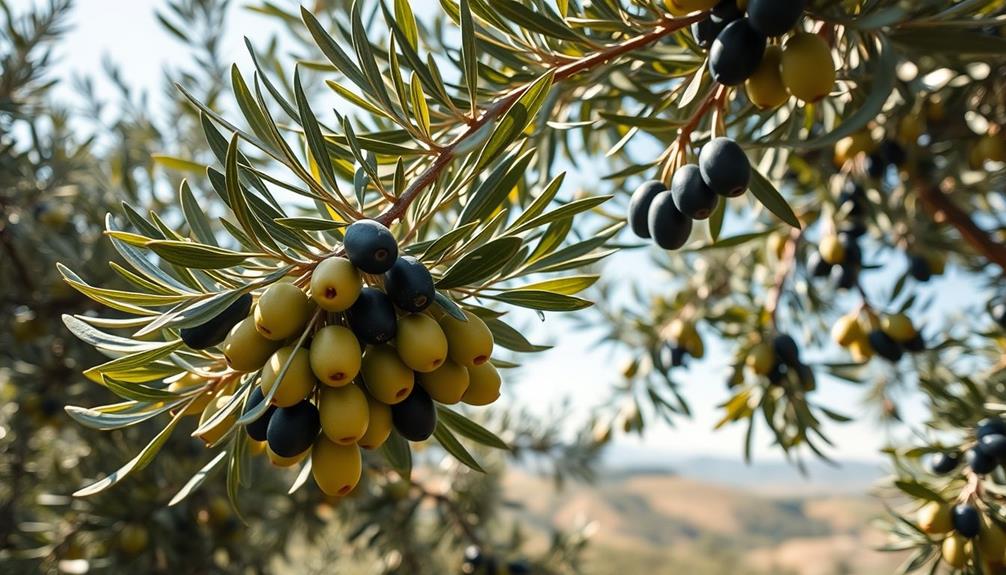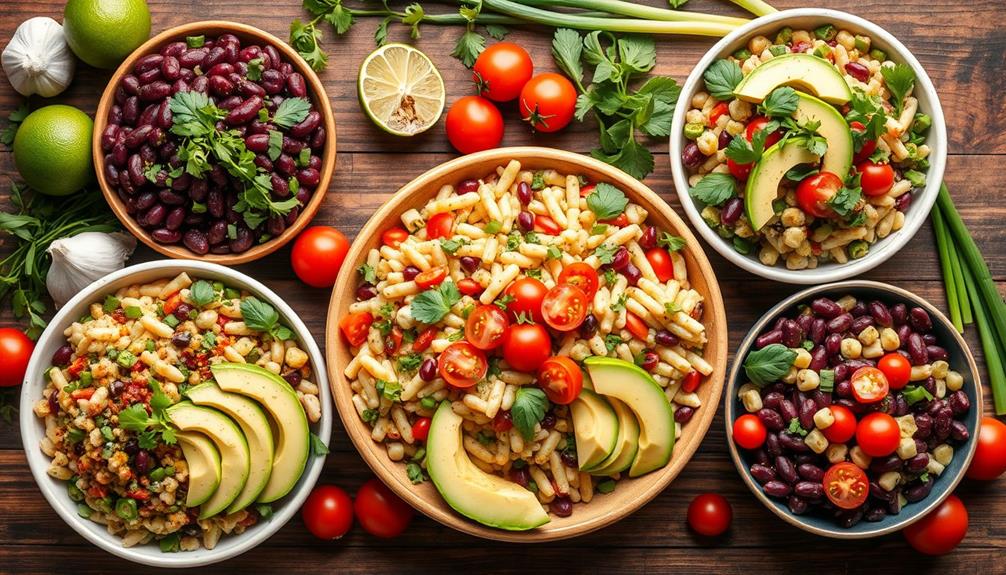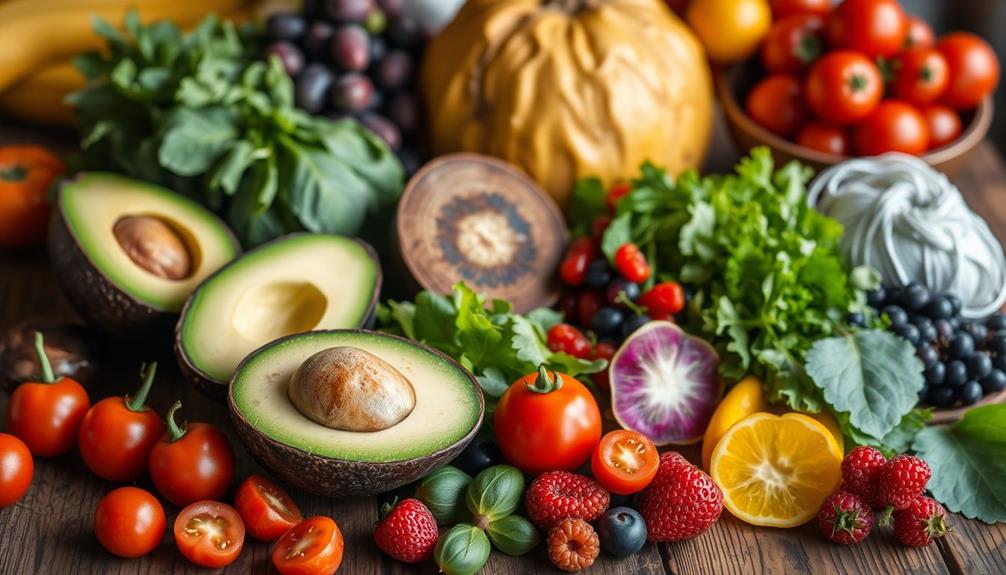Olives aren't raw food because they need curing to make them edible. Fresh olives are too bitter due to high oleuropein levels. Common curing methods, like salt curing or brine packing, can strip away their natural qualities and often involve additives that compromise their raw status. While some non-pasteurized, brine-cured olives might be classified as raw, many store-bought options use lye, which definitely doesn't fit the raw food criteria. If you're curious about the different types of olives and their health benefits, there's plenty more to discover about how to incorporate them into your diet effectively.
Key Takeaways
- Fresh olives are inedible due to bitterness and require curing to be palatable, often disqualifying them as raw food.
- Curing methods, such as salt curing, can preserve the nutritional benefits, but many commercially available olives are lye-cured, not raw.
- Raw olives can be sourced from specialty retailers, focusing on non-pasteurized, brine-cured options for a true raw food experience.
- Incorporating olives into a raw food diet offers health benefits, including antioxidants and healthy fats, supporting heart health and digestion.
- Always check labels for raw certifications to confirm that olives align with raw food dietary standards.
Understanding Raw Food Diets
A raw food diet primarily focuses on unprocessed foods that haven't been heated above 104°F to 118°F. This means you'll be consuming fresh fruits, vegetables, nuts, seeds, and legumes, which are considered raw.
If you choose a raw vegan approach, you'll eliminate all animal products, while a raw vegetarian diet allows for raw eggs and dairy. On the other hand, a raw omnivorous diet includes raw animal products.
Key preparation techniques in a raw food diet enhance digestibility and nutrient absorption. Soaking, sprouting, dehydrating, and juicing are common methods that help you maximize the health benefits of your meals.
For instance, juice diets may lead to nutrient deficiencies if not balanced. Adopting this lifestyle can lead to increased nutrient intake and weight loss, but it requires careful planning to avoid deficiencies in essential nutrients like protein, vitamin B-12, and omega-3 fatty acids.
While many adherents report improved digestion and energy levels, be cautious, as consuming raw animal products can pose risks. Additionally, certain toxic raw foods should be avoided.
Incorporating good fats from sources like nuts and seeds can further enhance the benefits of your raw food diet.
Types and Varieties of Olives
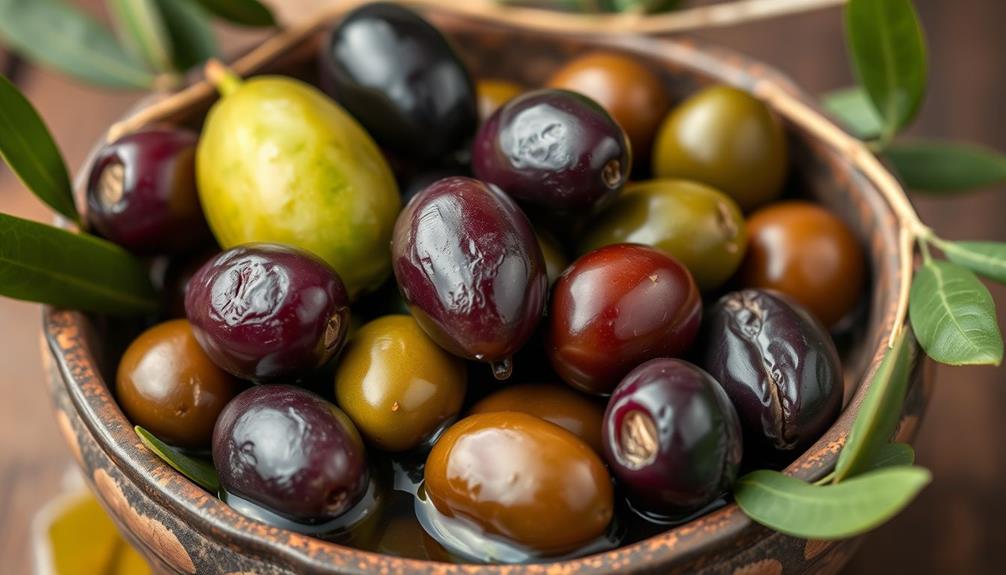
Olives come in a fascinating array of types and varieties, each offering unique flavors and textures that can elevate any dish. With over 150 olive varieties, you'll find options suited for both oil production and as table olives.
Different curing methods, similar to those used in brewing methods, play an essential role in enhancing the flavor of olives. The color and taste of raw olives vary based on their ripeness, ranging from green to black.
Here are some popular olive varieties you should know about:
- Kalamata: Almond-shaped, rich flavor; perfect for salads.
- Arbequina: Small and versatile, often used for oil production.
- California Sevillano: Cracked for better flavor absorption during curing.
- Oil-packed olives: Typically considered superior in quality.
These olive varieties undergo specific curing processes to remove their natural bitterness, making them more palatable. Curing methods like salt curing and brine packing influence their flavor profiles.
Incorporating olives into your meals not only enhances taste but also aligns with the Mediterranean diet, recognized as a health food. With so many options, you can easily find the perfect olives to complement your culinary creations.
Curing Methods Explained
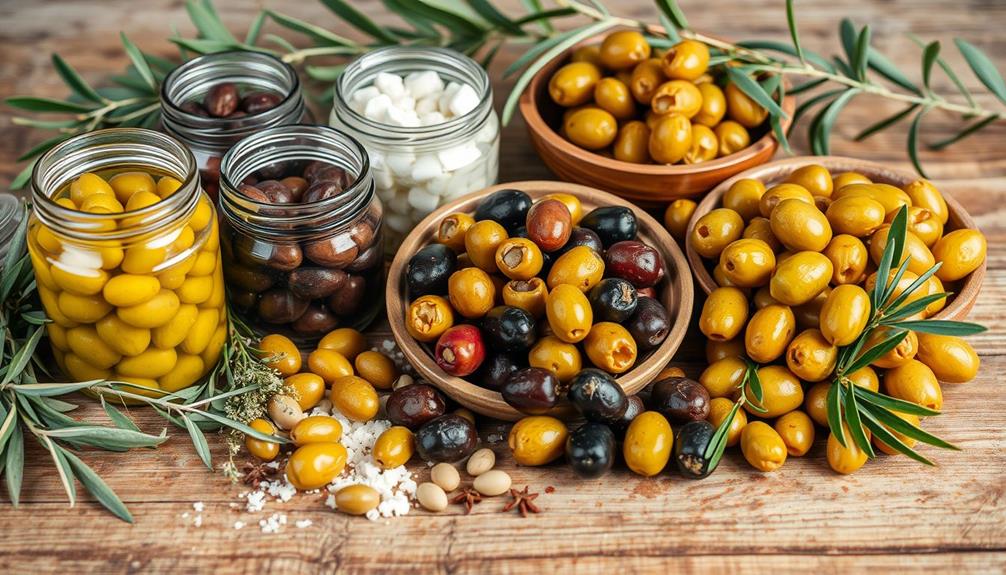
Curing methods play an essential role in transforming raw olives into the flavorful and enjoyable ingredients we love. Fresh olives are inedible due to high levels of oleuropein, which gives them a bitter taste. To remove this bitterness, various curing methods are employed, much like how specific cold medications are chosen for effective relief from symptoms.
Lye curing involves soaking olives in a sodium hydroxide solution, altering their chemical composition. While effective, this method often raises health concerns due to the use of chemicals.
On the other hand, salt curing, which uses sea salt, is considered a more natural approach. It draws out moisture and bitterness, resulting in a more flavorful olive while retaining some health benefits.
Oil curing is another option, but it's often mistaken for raw because it typically involves non-raw oils that may be heated during processing, thereby compromising the raw status of the olives.
Each curing method impacts the flavor and texture of the olives differently, allowing you to choose based on your taste preferences. Whether you prefer the more traditional salt curing or the quicker lye curing, understanding these methods helps you appreciate the journey from raw olives to delicious, cured delights.
Health Benefits of Raw Olives
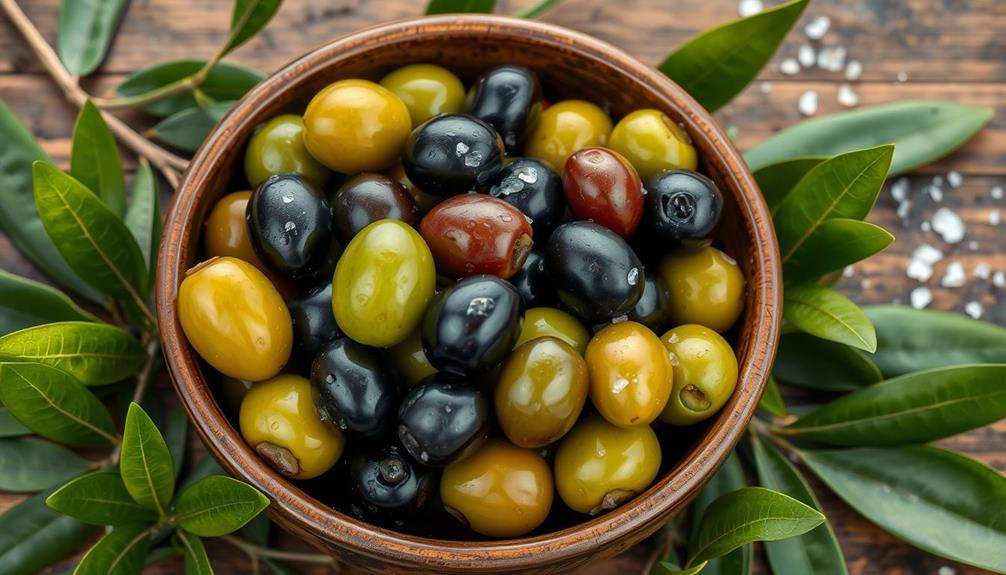
Enjoying raw olives offers a wealth of health benefits that can enhance your overall well-being. These nutrient-dense fruits are packed with antioxidants, including Vitamin E, which helps reduce oxidative stress and inflammation in your body.
Additionally, incorporating raw olives into your diet can be complemented by adding butter's health considerations to maintain a balanced approach to nutrition. Incorporating raw olives into your meals can support heart health by regulating cholesterol levels, lowering your risk of cardiovascular disease.
Here are some key benefits of including raw olives in your meals:
- Rich in Antioxidants: Combat free radicals and promote cellular health.
- Heart Health: The mono-unsaturated fats in raw olives help manage cholesterol levels.
- Gut Health: Their fermented nature supports beneficial gut bacteria, improving digestion.
- Wellness Boost: Raw olives provide essential healthy fats and vitamins that contribute to overall wellness.
You can often find raw olives at your local health food store, making it easy to add this superfood to your diet.
Sourcing and Availability
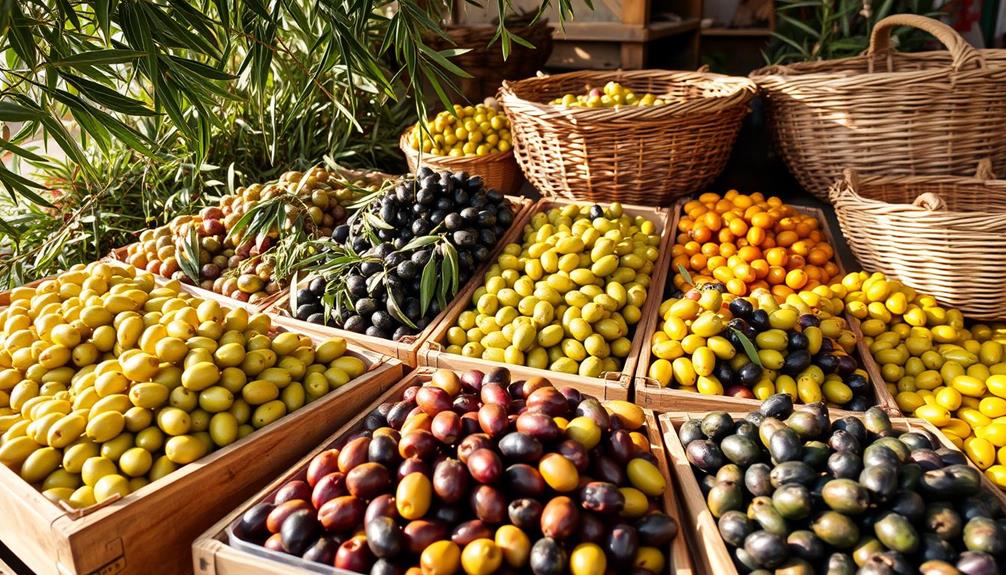
When it comes to sourcing raw olives, you'll find that the options can be somewhat limited. Fresh olives right off the tree are often inedible due to their bitter flavor, as they require curing to become palatable. This makes fully raw olives a rarity in retail settings.
However, you can find non-pasteurized, brine-cured olives from specialty online retailers like Natural Zing and Detox Your World, which focus on unprocessed foods. Understanding the importance of budget planning can also help you allocate funds for high-quality, organic options.
While these raw olives may come at a premium price due to the careful curing process, they're worth it if you're looking for a truly organic option. Many store-bought olives are cured using lye, disqualifying them from being considered raw.
Consequently, it's crucial to check labels for raw certifications to verify you're getting what you expect. If you're unsure about the raw status of jarred olives, it's a good idea to reach out directly to the companies for clarification, as misrepresentation can occur in the market.
Frequently Asked Questions
Are Olives Considered a Raw Food?
Olives aren't typically considered raw food since they require curing to remove bitterness. You'll need to find specific suppliers for truly raw varieties. Always check labels and verify processing methods before consuming.
Why Don't We Eat Raw Olives?
Imagine biting into a bitter treasure—raw olives are just that. You don't eat them because they're inedible without proper curing, which removes harmful compounds and transforms their taste from unpleasant to delightful.
Can I Eat Olives Straight From the Tree?
You can't eat olives straight from the tree. They're incredibly bitter and inedible due to oleuropein. You need to cure them first to make them tasty and safe for consumption. Cured varieties are your best option.
Are Olives Cooked or Raw?
You might think olives are raw, but most are cured, making them processed. If you want truly raw olives, look for specialty brands that offer unprocessed options, ensuring you enjoy their natural flavor without additives.
Conclusion
So, are olives raw food? It depends on how they're prepared. While fresh olives straight from the tree are raw, most you find in stores are cured, altering their state. If you're aiming for raw food benefits, seek out raw, unprocessed olives or explore local markets for fresh options. Embracing these choices not only enhances your diet but also connects you to the rich traditions of olive cultivation. Immerse yourself in the world of raw olives and savor their natural goodness!

